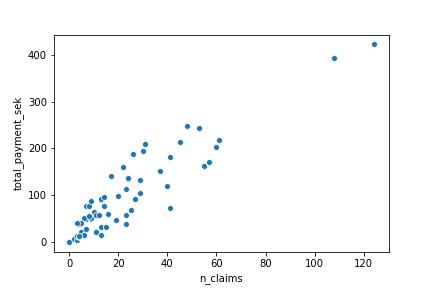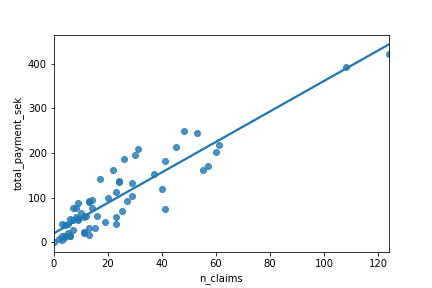A tale of two variables
Introduction to Regression with statsmodels in Python

Maarten Van den Broeck
Content Developer at DataCamp
Swedish motor insurance data
- Each row represents one geographic region in Sweden.
- There are 63 rows.
| n_claims | total_payment_sek |
|---|---|
| 108 | 392.5 |
| 19 | 46.2 |
| 13 | 15.7 |
| 124 | 422.2 |
| 40 | 119.4 |
| ... | ... |
Descriptive statistics
import pandas as pd
print(swedish_motor_insurance.mean())
n_claims 22.904762
total_payment_sek 98.187302
dtype: float64
print(swedish_motor_insurance['n_claims'].corr(swedish_motor_insurance['total_payment_sek']))
0.9128782350234068
What is regression?
- Statistical models to explore the relationship between a response variable and some explanatory variables.
- Given values of explanatory variables, you can predict the values of the response variable.
| n_claims | total_payment_sek |
|---|---|
| 108 | 3925 |
| 19 | 462 |
| 13 | 157 |
| 124 | 4222 |
| 40 | 1194 |
| 200 | ??? |
Jargon
Response variable (a.k.a. dependent variable)
The variable that you want to predict.
Explanatory variables (a.k.a. independent variables)
The variables that explain how the response variable will change.
Linear regression and logistic regression
Linear regression
- The response variable is numeric.
Logistic regression
- The response variable is logical.
Simple linear/logistic regression
- There is only one explanatory variable.
Visualizing pairs of variables
import matplotlib.pyplot as plt
import seaborn as sns
sns.scatterplot(x="n_claims",
y="total_payment_sek",
data=swedish_motor_insurance)
plt.show()

Adding a linear trend line
sns.regplot(x="n_claims",
y="total_payment_sek",
data=swedish_motor_insurance,
ci=None)

Course flow
Chapter 1
Visualizing and fitting linear regression models.
Chapter 2
Making predictions from linear regression models and understanding model coefficients.
Chapter 3
Assessing the quality of the linear regression model.
Chapter 4
Same again, but with logistic regression models
Python packages for regression
statsmodels
- Optimized for insight (focus in this course)
scikit-learn
- Optimized for prediction (focus in other DataCamp courses)
Let's practice!
Introduction to Regression with statsmodels in Python

